The wooden floor in any room over time inevitably begins to bend ... ...
|
|
The demand for ceilings from wood has repeatedly experienced ups and falls, and if in ... |
Mosaic tiles can give sophistication and originality even the most ... |
DIY waterproofing
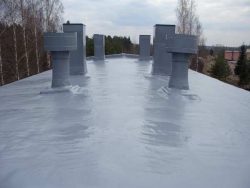
Roof waterproofing is one of the mandatory stages of its arrangement. To process the roof so that it does not leak out after the first long rain, the task is extremely important. Who wants to return to roofing in a month or two, six months or a or or or or or twin to stop the leak? Therefore, we do everything immediately, thoughtfully, using high -quality modern materials.
Before you dwell on different types of roof waterproofing and consider the waterproofing technology of the roof, we will make a reservation what roofs there are. After all, waterproofing solutions will vary from whether you are erecting a flat or pitched roof. The waterproofing of the flat roof and the waterproofing of the pitched roof differ both by materials and the method of installation.
The safety of the insulation and the operational characteristics of the entire roof will depend on how high-quality waterproofing the roof with your own hands will be with your own hands. At the same time, remember that moisture can come both from the outside and in the form of a pair that gathered in a nibbled space.
- Materials for roof waterproofing
- Polymer membranes
- Crystal waterproofing
- Mastic
- Coloring waterproofing
- Bloody waterproofing
- Penetrating waterproofing
- Waterproofing film
- How to make a waterproofing roof?
Materials for roof waterproofing
They are divided into types of composition and method of application:
- waterproofing perforated film (hydraulic barrier), anti -condensate film;
- polymer films-membranes (PVC membranes, EPDM membranes, spike-shaped, superdiffusion membranes);
- hydrophilic rubber;
- coating waterproofing (acrylic, bitumen, silicone, rubber, polyurethane mastics, one- and two-component materials);
- sprayed waterproofing materials (polymochevin, two -component acrylate compounds, liquid rubber);
- injection materials (polyurethane, acrylate, silicate resins, cements, emulsions);
- penetting materials (semi- and penetrating materials).
Polymer membranes
One of the latest technologies in the market of modern waterproofing materials. PVC membranes, PDM membranes and diffuse membranes are distinguished.
The latter are such species:
- diffuse with microperforation;
- superdiffeous;
- anticandenate.
Diffuse membranes with the presence of microperforation and superdiffuse are suitable for all types of roofs. For a membrane with microperforation, it is important to leave a gap between the material for the waterproofing of the roof and the heat insulator during installation, such a gap is not needed for superdiffusion. SuperDiffusion membranes are most acceptable for attic rooms, anti -condensate membranes, in which non -tan material absorbs the entire condensation of the best option for a roof of metal tiles.
The service life of membranes is up to 25 years. They are durable, have fire and environmental safety.
Multifunctional and PVC membranes. This is good material both for the construction of a new roof and for the repair of the old. The waterproofing of the roof, the cost of materials for which is impressive, will turn into continuous pleasure with similar membranes. Since this is done once every 25 years, it is important to choose good specialists. They will create a solid waterproofing with the help of welding. Such a film of 3 components consists of: PVC layer of a certain color, a layer of reinforced polyester and another, gray, PVC layer.
Members are sold in narrow rolls. They are attached using mechanical, ballast methods or glued. The ballast method for roofs with a slope angle up to 10%. The membrane is laid on the roof, fixed along the perimeter of the canvas, covered with gravel or gravel. Very often the method is used in the construction of an inversion roof. If you cannot create additional pressure on the roof, use mechanical fastening: nails, screws, brackets. If the roofs have a complex configuration, the membrane is glued.
PDM membranes are not only multifunctional (suitable for all roofs): they are suitable for roofs of the most crooked and curved, with any angle of slope. The sheets of membranes are laid one to one, and a self -adhesive tape is provided in the joints.
If such a membrane is used to install the roof waterproofing flat, then a layer of bulk materials is filled with on top. On the pitched roofs, the panels are attached or glued. Neither frost nor the sun is terrible for such material: it will last from 25 to 50 years. Thanks to the elasticity of the PDM membrane, it can be lengthened by 250-300%, to take the shape of the covered surface. The sharp ends of the roof and chemicals in the form of fuel and lubricants (fuel-lubricants) and oils for the membrane are harmful. It also needs to be additionally treated with acrylic coating and updated it from time to time.
In the photo - the waterproofing of the roof using membranes:
How to do this correctly with the membrane waterproofing of the roof of the video.
Crystal waterproofing
This is primarily bitumen and the materials containing it. A coating from 5 mm to several centimeters is created on the surface. Over time, bitumen loses plasticity and can be destroyed with mechanical exposure. The service life is about 5 years.
Bitumen-polymer mastics is a new generation of coating waterproofing of the roof. The price of work on an area of \u200b\u200b1 m. It ranges between 30 and 100 dollars.
Mastic
Mastic is applied to a flat roof or roof with a minimum angle of inclination. In composition, mastic materials are bitumen-polymer, polymer, bitumen-resin. According to the application method, they are divided into hot (those that need to be pre -heated to 160C) and cold mastics (they are not required at a temperature of +5C and you need to heat to +70C if the temperature is below +5C).
Mastics adhere to the base perfectly, be it concrete, wood, metal. When they harden, create a continuous seamless rubber -like coating, the service life of which is at least 20 years. This type of waterproofing is also called the bulk roof, and the technology of its application resembles the creation of bulk floors.
Coloring waterproofing
This is the application of bituminous and polymer varnishes, paints, emulsions to coating. Coloring waterproofing can be applied manually or from a spray. Do this in 2-4 layers for greater strength. The thickness of the waterproofing layer is only 3-6 mm. On top of freshly, insulation is sprinkled with fine -grained sand in order to strengthen the coating. The promised service life is 5 years. When choosing materials for the roof, you need to give preference to plasticized polymerbitum compositions.
For work on painting waterproofing the roof, prices are many times greater than coating. On average, this is from $ 100 per 1 square. m.
Bloody waterproofing
This method is one of the oldest. It provides for the use of leafy and roller materials: roofing material, parcham, toly, glass block, isol, waterproof, brisle. Of the more new ones, these are viniplast, polyethylene, polychlorvinyl, isoplast, motoplast, isoelast, ecoflex.
The surface in this case should be dry and very even: irregularities are allowed up to 2 mm. After aligning and cleaning the surface, it is covered with a primitive layer of bitumen emulsion, and then glued the material. The sheets are overlapping 10-15 cm. Such waterproofing is sensitive to mechanical damage and is complex in installation. At the end of the work, it must be sprinkled with stone crumbs. At the same time, the temperature for the installation of the material should be at least +10 ... 15 C. But there are work on this type of waterproofing of about $ 10 per 1 sq. m.
Penetrating waterproofing
This type of waterproofing is applied to pre -cleaned surfaces with a porous structure. These include: concrete, limestone blocks, brick. The impregnation fills all the pores and cracks, penetrates deeper, but, freezing, such isolation not only prevents moisture from entering, but also strengthens the entire structure. As an impregnation waterproofing, liquid glass, liquid polymers, synthetic resins and molten bitumen are used. For applying the compositions, spray guns are used. The base itself must be carefully cleaned and degreased so that the composition can penetrate the pores and form crystals there. After such processing, water is met by cement and concrete do not leak.
Waterproofing film
This is the easiest and cheapest way of waterproofing, which is used for pitched roofs: under slate, tiles, metal tiles. It is used in the insulation of the attic or the attics with mineral wool and polystyrene foam.
Waterproofing on the pitched roof is laid, starting from the cornice, towards the skate.
If the angle of inclination of the roof is from 30 degrees, then the overlap between the waterproofing film is 150-200 mm, if the angle is from 15 to 30 degrees, then the overlap should be about 250 mm. In this case, the material should not be stretched: it must sag between the rafters by 15-20 mm.
We settled on the most common groups of waterproofing materials. Now let's look at which one is better to use.
How to make a waterproofing roof?
When the roof waterproofing is applied, which will be insulated foam polystyrene, in some cases, waterproofing film, and in some - nothing. Foam polystyrene itself, with sufficient insulation of joints, can serve as good waterproofing.
If you need to insulate and protect from moisture flat roof or make it inversion, then you can use different types membranes In combination with insulation. An even simpler option for a flat roof incorrect insulation in the form of the same mastics. At the same time, the use of mastic is relevant both on new roofs and sealing seams. Liquid rubberthe flat roof is also a great option.
If you still choose on rolled materials And you will carry out their installation, then pay attention to both the roofing material and the novelty - Euro -Ruberoid and Rubemast. If you plan to equip in the attic The attic, then in combination with vapor barrier and insulation can be applied superDiffusion membrane. The option is excellent, but not cheap. With roofs with a complex configurationexactly membranes The most acceptable option.

Experts say that with proper installation of slate, no waterproofing will be needed. Under the slate, the roofing material was once laid, now it is a hydraulic barrier or a perforated waterproofing film. The same material is used for metal tiles.
This film is attached to the rafters on the pitched roof or to the lags on the ceiling. Construction fasteners are used to connect building elements. As fasteners, stainless steel brackets or nails are used, auxiliary crate is mounted. For unscarried attics, such a film in combination with insulation is the most economical option that provides for a good combination of price and quality.
For roofs with folding roof, metal tiles and other types of metal roof Recommended anticandenate film. For laying an anti -condensate film, both the upper and lower ventilation gap is required. Therefore, an additional crate is made.

To use membranes, the lower gap is not needed.
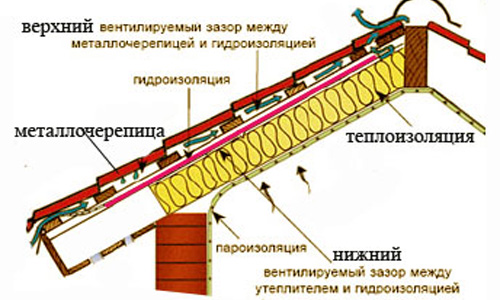
Concerning euro -hassle and folding roof, because they have very good thermal conductivity, this type of waterproofing with their own hands, like a diffusion membranenot applied.
For the fold roof exist volumetric dividing membrane.But for Slandseva Apply membranes And they provide one ventilation gap.
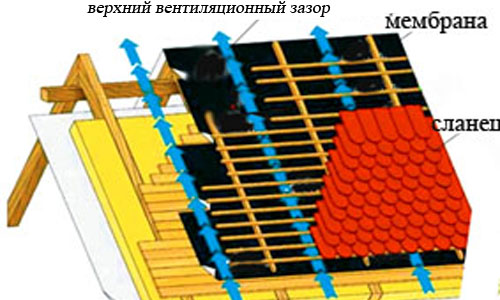
When applying anti -condensate filmthere should be two such gaps.
When choosing waterproofing for the roof of the nuances, there are a lot. But first of all, it is:
- roof shape (flat, pitched, complex configuration);
- purpose (operated or not);
- type of roofing materials (slate, tiles, concrete, metal tiles, Euro -shifer, fold, shale and other types of roofs);
- type of insulation.
Experienced craftsmen already have their proven recipes for combining better waterproofing for a particular roof pie. Having studied our tips, you yourself can choose an acceptable waterproofing option for your home.

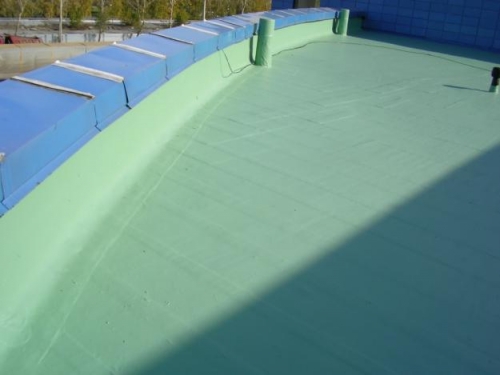

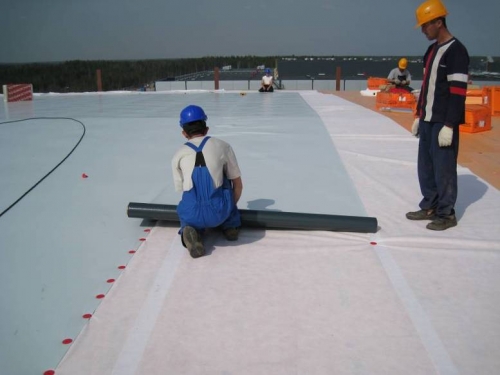

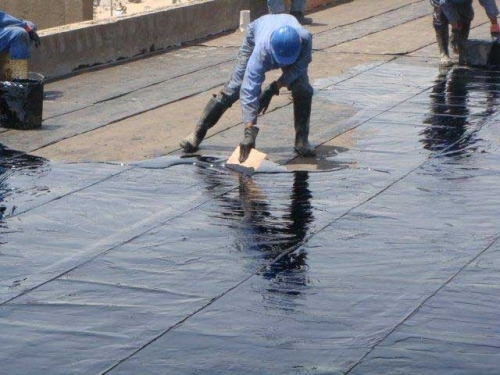




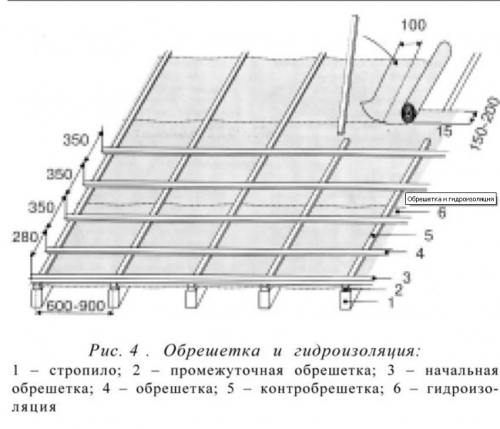

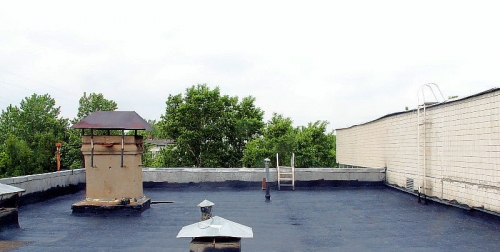
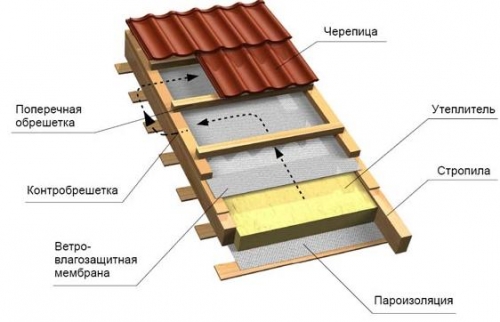

PPU insulation and waterproofing
PPU insulation and waterproofing polymochevina! High quality!!! 89297245950
Waterproofing for the roof of PBK
Waterproofing for the roof of PBC Izostop
Liquid waterproofing, liquid rubber tire
Roof waterproofing with your own hands from 90 p. square meter. After solidification, it forms a seamless frost -resistant and elastic membrane resistant to the external environment. Roof waterproofing + material from 350 rubles per square meter. Buy a bucket of 2200 rub. - https://izostop.com